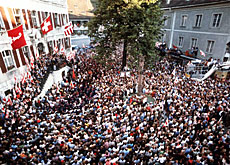Divisions remain over Switzerland’s newest canton

Twenty-five years ago the Swiss voted to set up a 26th canton in the Jura region, in the northwestern part of Switzerland.
For many people in canton Jura, the vote on September 24, 1978, was a great achievement – but relations with neighbouring canton Bern remain tense.
At the time, an overwhelmingly number of voters – some 82 per cent of the country’s 25 cantons – approved the creation of canton Jura, which was formed from French-speaking districts ceded by Bern.
The road to independence from canton Bern was a long and bumpy one, with the issue first raised back in 1815.
At that time, the Congress of Vienna – an international conference called to reshape Europe after the downfall of Napoleon – handed over the Jura region from the bishopric of Basel to canton Bern.
During the 1800s, citizens of the French-speaking and mainly Catholic Jura region felt discriminated against by the German-speaking, Protestant government in Bern.
They also felt that Bern was neglecting the economic and infrastructural needs of the region.
Crisis
In 1947 the crisis came to a head when Bern’s cantonal parliament snubbed a politician from the Jura region.
This led to a public outcry in the area and as a result, several separatist movements were formed.
In 1950 Bern attempted to defuse the crisis by granting further rights to the Jura region. But Bern’s initiatives did not go far enough, and in 1958 separatists launched a first attempt to split the Jura region away from canton Bern.
However, voters rejected the proposal at the ballot box.
In an effort to reconcile, the government of canton Bern granted seven northern districts in the Jura region the right to decide their future. But three southern districts – Moutiers, La Neuveville and Courtelary – remained under Bern’s control.
On January 1, 1979, three months after Swiss voters approved the creation of the 26th canton, the Jura constitution came into force.
Tense relations
Despite independence from Bern, tensions between canton Jura and canton Bern remained.
In 1989, the Rassemblement Jurassien separatist group (RJ) submitted a new initiative calling for the integration of the three southern districts into canton Jura.
But the Swiss Federal Court declared the initiative null and void in 1992, provoking a violent response from militant separatists.
In 1993, a member of the youth branch of the RJ was killed when a bomb destined for the cantonal parliament building in Bern exploded.
In a bid to end the conflict, a special Jura assembly was set up in 1994 – but even today problems remain.
In May Bern’s cantonal government proposed granting special status to the three southern districts to allow for greater autonomy in the areas of culture and education.
Separatists, however, rejected the move, and earlier this month the Jura Autonomy Movement launched a new round of proposals aimed at resolving the conflict.
swissinfo with agencies
After a history of conflict and resentment, problems between the French-speaking canton Jura and German-speaking canton Bern remain.
Although Switzerland voted to set up canton Jura in 1978, three southern districts remained under Bern’s control.
Separatists – who staged violent protests in the early 1990s – continue to demand greater autonomy.
On September 24, 1978 the Swiss voting population overwhelmingly approved the creation of a 26th canton.
On January 1, 1979 the Jura constitution came into force.

In compliance with the JTI standards
More: SWI swissinfo.ch certified by the Journalism Trust Initiative
You can find an overview of ongoing debates with our journalists here. Please join us!
If you want to start a conversation about a topic raised in this article or want to report factual errors, email us at english@swissinfo.ch.